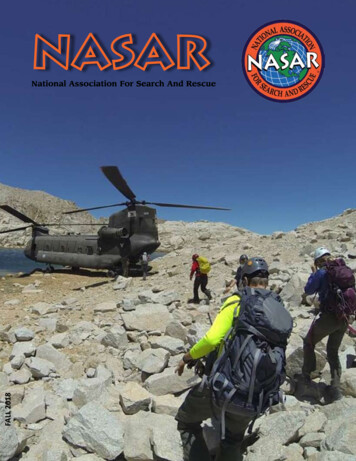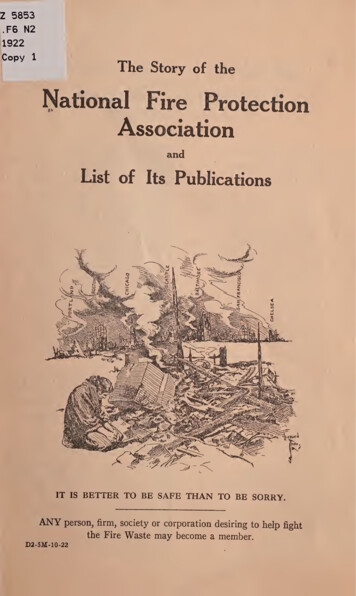
Transcription
FALL 2018National Association For Search And Rescue
Welcome to the newSAR Magazine!Mike VorachekNASAR President and EditorNATIONAL ASSOCIATION FORSEARCH AND RESCUEWe’ve finally been able to pull together a fairly significant projectin bringing the SAR Magazine back to life. The last issue I was able tolocate was the Winter 1984 edition, so this has been a project that hastaken 34 years to bring to fruition.Board of DirectorsPresident – Mike Vorachek (ID)Secretary – Mikki Hastings (AR)Treasurer – Earl Tilton (NC)Member – George Dresnek (CA)Member – John Peterson (NV)Member – Don Stephens (TX)Member – Craig Spieker (PA)BOD Elect – Dallas Lane (AZ)Executive DirectorChris BoyerCustomer Service ManagerEllen WingerdNASARP.O. Box 232020Centreville, VA here are several reasons why we have undertaken the project tobring back SAR Magazine. First, it provides us an opportunity to promotethe camaraderie of our profession. All of public safety counterparts havemagazines that address issues related to their profession. Admittedly,it will take us a long time to reach the levels of other magazines, butat least ours is free! Second, we are creating a publication that can bepassed on to others – on your team or in the doctor’s office lobby. Peopleare interested in our profession and we have a lot to offer. The fact thatmost SAR folks are volunteer, the specialized work we perform, and theenvironment we operate in all tie together to make this one of the oneof the most benevolent professions you can participate in.I would like to take a moment and thank our advertisers. Many ofyou were contacted while we were trying to establish the content of themagazine and really did not know what you were going to get for yourinvestment. We can only hope that your decision to support us is goingto pay off. We want to say THANK YOU for your support.For those history buffs out there, I went back to the Spring, 1978edition of SAR Magazine and pulled out a couple of snippets for yourenjoyment. NASAR 2018Search and Rescue Magazine is published by a private firm under contract withthe National Association For Search AndRescue. The appearance of advertisements for products and services, as wellas supplements and inserts found in thismagazine does not constitute endorsement by the National Association ForSearch And Rescue.Cover Photo: Marin County SAR (CA) doing a hot loadon a CH-46/47 from the CA National Guard above 10,000’in the Sierra Nevada Mountains.
The Leading EdgeBy Mark Smith, Mission-Centered SolutionsFull disclosure, I’m no search and rescueexpert. Before writing this, I didn’t knowthe Mattson Method from Method Acting.Although, from my Army special operationscareer, I do know a lot about leading in highrisk environments. Mountains, desert, jungle,arctic, maritime, caves, tunnels Rescued andrescuer; Lost and found.So, I write this article based on my convictionthat an incident is an incident and leadership isleadership. Chaos and synergy are universal. Ateam may be technically accomplished, yet realeffectiveness depends on leaders at all levelswith the right knowledge and tools, and aculture that encourages growth and confidencein their use.Continued }Cave Photo - Surface entrance transitioning to verticaldrop to main cavernINDIVIDUAL MEMBERSHIP BENEFITS INCLUDE: Discounts on NASAR Courses, Certifications, Products & Books SARTECH 1 Fees Waived (Recert Fees Waived for STI) Pro Deals on Outdoor Gear Through PROMOTIVE/EXPERTICITY Travel Discounts Through HOTELSTORM & Enterprise Rent-A-Car We are Adding New Benefits and Discount Programs ContinuouslyOnly 75Become a Member Today Receive a New Pocket Guideas Our Way of Saying ThanksPO BOX 232020, CENTREVILLE, VA 20120-2020INFO@NASAR.ORG (877) 893-0702 WWW.NASAR.ORG
In my current career, my team trains and consults with emergency response agencies and incident management teams (IMTs) on leader development and Mission-Driven Culture across the United States, Canada,and Australasia.In July 2015, in a limestone cave in a remote part of Victoria, Australia, a group of responders who, likeme, didn’t know much about SAR, exercised impressive leadership to successfully resolve a challengingSAR incident. Since so many SAR responders around the world are volunteer or seasonal, it’s relevantthat all the people who established command and ran the incident were volunteers. In this case, volunteerfirefighters.Our story really starts the night before the actual cave rescue during one of our leadership courses. Thisvolunteer course was broken up over two weekends, at an isolated camp. On the first Saturday night, aftera day in class, we go hands on and apply the core concepts during a night exercise.Teams are dispatched to calls and a seriesof events lead to incidents becoming morecomplex. Heavy rain, very dark - the perfectenvironment to put the leadership principlesinto practice.The Fog of War, a 200-year-old metaphor forthe friction, danger and uncertainty inherent inchaos, was thick that night. Pea soup thick. Thegroup experienced (i.e. created) communicationbreakdowns, lack of situational awareness, poororganization, personnel accountability issues,a few overwhelmed leaders and a whole lot offollowers standing around in the dark. It’s what my colleagues and I call “a rich learning experience”.At the after-action review, they were beating themselves up. “We know better than that!” They left with alittle fire in the belly to “have another crack” and apply the lessons to the following weekend’s exercises.We finished Sunday morning’s training and after a meal everyone headed out on the only road back tocivilization.The group carpooled in their admin vehicles – a loose convoy with several minutes between cars. 6.5 milessouth, still 23 miles to the nearest small town, the lead vehicle encountered a young girl waving her armsflagging them down. Pulling over, the 11-year old told them that a woman was hurt and trapped in a cavea half mile off the road. The cave was part of a large complex stretching several miles.They had no equipment, other than their individual gear. Murphy’s Law ensured there was no cell phonereception in the area and spotty radio comms.What could they do? They were not SAR, confined space, rope rescue, or cave experts.But the previous night had increased their expertise in leadership,teamwork, communications and decision-making exponentially.The course centers on the values of a Mission-Driven Culture, andone of the key concepts is the difference between operators andfollowers. Followers wait to be told what to do. Operators alwaysseek to influence their environment to accomplish the mission.Everyone is a leader.
So they went to work.The first three people secured the roadside. One interviewed the young girl, treating her as a valuable sourceof situational awareness. One assumed responsibility as incident commander and established a controlpoint. One started communicating back to dispatch and scribed for the IC.A second vehicle pulled in with a paramedic. He and two other firefighters formed a search team to locate,evaluate and stabilize the victim, bringing blankets and water. They considered the danger/opportunityof allowing the young girl to guide them. Assessing she was level-headed and capable, they relied on herlocal knowledge, flagging the route as they went. It was a difficult path and they realized they would havestruggled to find it without her.The search team navigated the vertical mouthof the cave and subsequent narrow passages tofind a woman with a broken ankle and possiblespinal injuries, trapped in a small chamber ofstalagmites.The remaining volunteers got the organizationalstructure in place. Within a few minutes, theyordered a High Angle Rescue Team that couldarrive in 3.5 hours, and requested lighting fornight operations.Cave Entrance Photo – entrance camouflaged by foliageBecause radio coverage was unreliable, theyimplemented PACE (primary, alternate, contingency, emergency) communications by establishing runnersand relays so there was always a link within visual and voice range.Everyone got briefings – eventually one personguided all incoming resources to the cave andbriefed them along the way, checking that everyonehad adequate equipment for the environment.The paramedic stayed with the patient and the twoaccompanying then drove back to the camp wherewe did our course and organized catering. Oneeventually acted as a liaison with the assemblingfamily, sharing and gathering new information.A brand-new captain, a pixie in stature, took onthe role of staging and check in manager andinterposed herself in front of big, salty crew leaders of follow on units who wanted to go right intoaction. “You either check in, properly, or you packup and go home!” They quickly complied withcompleted T-Cards.Org chart & graphics used to brief the leadershipclass the next weekendAs the far more experienced technical specialists eventually arrived from three different agencies – fire,police and rescue – along with higher-ranking chiefs, they all reached the same conclusion. “These peopleknow what they’re doing.” And they went to work, fitting into the existing structure in operational or liaisonroles but leaving the cohesive IMT of our students of leadership intact.
The rescue itself was challenging.Terminology I hazily recalledfrom my Army days - NorwegianReeve, butterfly, double becketbends, triple stack prussiks. Asthe night progressed, the patient washighlined into the main cavern, thenre-rigged to cross the 30-90 degreeslope up and out of the mouth ofthe cave. She recovered fully aftertreatment.Technical Photo – Looking through a horizontal passage to interiorchamber where patient was trappedWhat led to success? Our studentshad no more knowledge of theincident command system on thatSunday than on Friday morningbefore the training. What wasdifferent?To begin with, some very fresh lessons that ICS is just a system. Leadership drives the system. They hada whole new kit bag full of tools and techniques based on the concepts and principles of leadership andMission-Driven Culture.They chose to be operators, not followers, taking responsibility to lead and communicate, regardless ofposition. One later stated: “At the night exercise a lot of us stood around waiting to be told what to do. Atthe cave we made sure we all knew what was happening and had roles.”They had the confidence to lead based on mutual trust and experience with what right and what wronglooked like from their weekend together.Younger volunteers later said the first halfof the course “ gave me the confidenceto take action.”, or to “ speak up whenthings didn’t look right and ask if thingsweren’t clear.”When you build your team’s leadership abilities and encourage a culturefor their use, you build a better team.Synergistically, they also become moreeffective in their regular jobs and otherpursuits. Recruiting and retention ofyour program will grow as people see avaluable return on their time. Developingoperators is essential to any team’s leadingedge, no matter your brand of chaos. pPhoto-Briefing the Cave Rescue during 2nd weekend of courseMark Smith is a partner in Mission-Centered Solutions, based in the Denver, Colorado area.www.mcsolutions.com
SAR 40 YEARS AGOSNIPPETS FROM THE SPRING1978 ISSUE OF SAR MAGAZINE
The Meaning of Search and RescueShaun RoundyYou’re comfy and warm and sound asleep at 3:00 a.m. when the search and rescue alert drags youabruptly out of dreamland.You have three hours left in your workday when the notification arrives that a child has gone missing from a local campsite.You just sat down to Thanksgiving dinner with extended family when you learn that a truck has slidoff the road and into the river, or some kids went hiking and got stuck on a cliff, or a backcountryskier broke her leg and may bleed or freeze to death if you don’t get up right now and find her.So you get up and go. You get in your car and drive, paying for your own gas and most of the gear youneed to bring today’s patient home safely. You do this day after night after day, month after month, yearafter year. Then you go back to your life and act as if nothing extraordinary happened today, as if you’reno hero and any decent human being would have done the same.But why? What drives you to continue volunteering your time, money, comfort, and - sometimes - riskingyour safety to rescue strangers who you’ve never met and will probably never see again? In my experienceand observation, only one thing has the power to motivate such ongoing selfless action, and that is a Senseof Meaning.“Meaning” simply means that you find something important enough to prove rewarding and satisfying;regardless of how pleasant or unpleasant you find the task itself. It’s wired deeply into our brains as oneof its most potent motivators. It can transcend pleasure and pain, outlast threats and duty, and shape livesand destinies.My question for you is whether you’re extracting the maximum amount of meaning, and thus, motivation,from your SAR service? Test yourself with the following questions to find out whether you’re missing anyopportunities to multiply your meaning:1. Is your gear ready to go for the next mission?2. Are your skills practiced and sharp?3. When the call comes, do you eagerly respond?4. Do you look forward to seeing your SAR friends at meetings and trainings?5. Do you feel like your participation makes a difference in mission outcomes?If you answered no - or hesitated - to any questions, then the following stories are designed to point outopportunities for extracting more meaning from SAR service and allowing that to motivate you to greaterenthusiasm, dedication, and intrinsic, personal reward:
Contribution: Just In Time!It’s easy to observe the difference you make in the world when, as my team did earlier this year, you plucka woman from a high cliff moments before exhaustion causes her to fall to her death.One of my all-time favorite missions involved a climber who fell fifty feet and landed on his face, whowe spent all night lowering over half a dozen waterfalls and down a rocky mountain trail to a waitingambulance. It was a favorite mission because it was difficult, and because it mattered - the boy may nothave survived without us.I got into my car as the eastern, pre-dawn sky began to glow with a hint of approaching daylight, andturned on the radio to a public service announcement about donating blood. “Today, I read a book,” saidone voice. “I mowed my lawn,” said another. “Oh, and I saved a life,” they added. “So did I,” I thought tomyself, and it felt pretty darn good.It’s more difficult to glean the satisfaction from making a difference when you respond to a lost child, asmy team did two weeks ago, only to turn around after driving for twenty minutes because the child returnedto camp on his own. Even so, it’s useful to remember that even the mere act of being ready and willing torespond to emergencies is significant. 80% of life is just showing up, they say, and if you make it that far,you’re sure to go much farther.My favorite rescue story from recent years prevented tragedy in a rather unusual and entertaining way.A couple on a date went hiking and got ledged out between cliff bands. For them, it must have been anintense and perhaps traumatic experience, while for my team, it was about as simple and commonplace asthey come, not the sort of situation where I expected to find much meaning.I made my way to the couple and lowered first the girl, then the boy, to safety. When the girl reached myteammate below, waiting to lead her back to the trail, she exclaimed, “You guys got here just in time! Iwas about to tell him I love him!”Identity: I Am SARA man joined my team many years ago and brought with him a very nice jeep. He gave me a ride up asteep hillside one evening, and proudly pointed out its various special features. His attendance at trainings,missions, and meetings didn’t add up to the requirements for a first-year member, however, and he waseventually cut from the team. For years afterward, we would spot his jeep around town now and then, itsback window still adorned with “Search & Rescue” in large, reflective letters. A deputy eventually caughtup with him and made him at least remove the sheriff star.This appears to be an example of someone who joined SAR for the wrong reasons - or at least what wemight consider less-noble reasons - for status and prestige. Ego alone rarely provides enough meaningto motivate ongoing commitment and dedication when calls come at such inconvenient hours and newmembers discover what an expensive hobby SAR can be. They tend to cull themselves from the team longbefore they get let go.Why, then, am I sharing this story as an example of meaning and motivation? Because it clearly illustratesa point where many SAR volunteers veer in the opposite direction and fall short. Rather than taking pridein what they do, they humbly assume they’re nothing special, but they are!YOU are! You are a rescuer, and like it or not, that makes you a hero. You need not assume you’re betterthan anyone else, but you ought to at least accept the truth, that your selfless devotion makes the worlda better place by saving lives and inspiring those who witness your actions, whether that’s a lone lost10
hiker in the dark of night, or millions watching a news story from the comfort of their living rooms. Byacknowledging that you’re a valuable part of the team, you open the door to more fully experience thesatisfaction of a job well done.Connection: Training HoursMy team’s Singletrack Special Team was born when my teammate Chris and I bought motorcycles onesummer. Dirt bikes let us access endless miles of dirt trail in a fraction of the time they would take to hike.Others soon joined the ranks, and the SST has proven extremely useful dozens of times since then.When a pair of disoriented hikers called from the Ridge Trail one summer night, we strode over to thecommand post and pointed at their map. “They’re either right here or right here,” we assured them. “Thoseare the only two places you can feel lost on the Ridge Trail.”After riding seven miles in the dark, we found our lost hikers huddled around a campfire exactly wherewe predicted. “I’m Shaun and this is Chris,” we introduced ourselves. “We’ll be your rescuers thisevening.”“Your knowledge of these trails is invaluable!” our commander confided when we returned to CP. Thatdepth of knowledge never would have happened without the bond of friendship which kept us “training”together almost every week from spring to fall for several years.Summary: Vitamin MContribution, Identity, and Connection are not the only sources of meaning and motivation - you could alsoadd duty, adventure, spending time in nature, getting off work (if your boss recognizes the importance ofwhat you do and supports your participation), and more. Furthermore, others may not find meaning fromthe same sources as you - but as long as they’re motivated to show up and contribute to the team’s success,there’s no point in judging them for any differences. The point is to take care of number one by makingsure you’re getting enough Vitamin M to keep you going strong and happy for many years to come. pShaun Roundy is an 18-year volunteer on the Utah County Sheriff Search and Rescue team, wherehe has served as vice president, secretary, mountain rescue team sergeant, webmaster, and more.He has chaired the Mountain Rescue Association’s Intermountain Region for ten years, foundedthe MRA Webinar Committee, and wrote the book 75 Search and Rescue Stories, an insider’s viewof survival, death, and volunteer heroes who tip the balance when things fall apart, available onAmazon.com and UofLIFE.com/books.11
Texas Civil Air Patrol MembersComplete SARTECH CourseFour members of the Texas CAP completed the SAR Tech-II course and 6 completed ST-III programduring the Lone Star Emergency Services Academy held June 25 through July 1st in Nacogdoches. LeadInstructor was NASAR Board Member Don Stephens. SAR Tech Evaluator Kim Stephens and Search DogOlivia also in photo. Photo by Joel Smith.JOINTODAYwww.nasar.org12
Introduction tousing K9 TeamsDavid FergusonWhy would a SAR team want to use a SAR K9 team ona search mission? What can they bring to the mission?For the purpose of this article a K9 team is the dog andthe handler. Sometimes they are joined by a supportperson or flanker. The K9 team is trained to help findmissing people using human odor either alive or deceased. The dog is trained to “tell” its handler that ithas detected odor of the missing person or any person in general. Because the dog doesn’t speak in wordsthe handler is trained to understand the dog’s behavior (body language) and the dog is trained to perform aspecific indication behavior, usually both learn to interact with the other. In other words, the dog is a targetodor detector or sensor and the handler is a body language interpreter. Because a dog is more efficient atsmelling the trained odor than a person, the team can be more effective. Most human searchers look forvisual clues where as a K9 team compliments that with an odor search for higher POD.What should you expect when dealing with a K9 team? There are a couple of ways to look at this question. First, a K9 team is more effective if there aren’t lots of other people in the search area – conflict odorsources. The team works better when it is not too hot or not raining too hard. This means a number of teamsprefer to work out front of other teams or at night when there aren’t so many people searching. Second,the K9 team should be part of the whole search – not the center of attention. They should follow the ICS,preform their assignment to the best of their ability given the conditions, be prepared for the conditions,report the results of their efforts honestly including the areas not covered, they should not undermine theoverall team, and be an asset and not a liability.How to make best use of a team? The overly simple answer is to apply them so that they can be the mosteffective (this is also true of all teams). “Most effective” means that their POD is the highest for the situation and conditions and at the lowest ‘cost’. Cost being time, money, or risk. This is done by matchingtheir skills and experience against the target odor and situation. But, how does a search planner do this?The best answer is experience with that particular K9 team or, secondarily, an acceptance of the certifying agency for that team. It helps to go watch them practice. Please understand that there are a number ofnational certifying agencies, regional certifications, and some agencies preform internal certification. Thekey point here is that the search agency or manager be comfortable with the certification.A lot of the time a K9 team won’t directly find the object of the search but instead the K9 may find scentclues or lead the K9 team to physical clues. Most SAR management knows that clues are the key to solvingthe mystery. And the key is tracking, plotting the clues on the SAR map, and using all the clues to focusthe search effort. There are a couple of ways that these scent clues are found. The first and foremost is thatthe handler recognizes behavior changes in the dog. The classic is “my dog has never done that before – Iwonder what is going on.” These events should be added as a waypoint to their GPS and the wind directionand variability noted. Then these events should be reported as part of the debriefing process.In closing, a K9 team is part of the whole SAR team – treat them that way. It is through the whole teamthat any given mission is accomplished. K9 teams are not magic or superhero’s – just trying to help.“Improvise, Adapt and Overcome!” Clint Eastwood, Heartbreak RidgeDavid has 33 years in SAR and is pictured with his third K-9, Lily. He is a member ofSnake River Search in Idaho13
FEATURED TEAMRed Rock Search and RescueRed Rock Search and Rescue was formed in January of 2012 after a hiker named Ron Kirk went missing inRed Rock Canyon near Las Vegas. At the time, the only SAR team was the Sheriff’s heli-borne technicalrescue team. The Sheriff’s team was made up of a handful of volunteers and deputy officers. They did nothave the resources to search massive land areas, especially when the probability of detection was a low. LasVegas Metro Police Department Search and Rescue launched multiple operations but were unable to locateRon. Eventually they had to call off the search due to lack of resources, but Ron’s friends and membersof local hiking and running clubs kept the search going, gathering more than 200 volunteers to comb thearea searching for Ron. David Cummings, a veteran SAR member from California, who then lived in LasVegas, realized Las Vegas did not have a ground pounding SAR team.David began to organize people who were showing up to help search for Ron. It was one of the most amazing things this author has ever seen someone do in a real crisis. Within a few days, David had organizedseveral search teams, had maps, and had almost every hill, peak, and valley checked off as being searched.He taught people grid searching techniques, map, and compass usage. Searches continued for weeks andfinally, on March 10, 2012, Ron’s body was found in one of the most treacherous areas of Calico Basin.In the weeks to come, David began to organize. He was supported by a generous donation from Ron Kirk’sfamily and Red Rock Search and Rescue was founded by David Cummings, Dana Richardson, and JDLaguana with the goal of building a team who could continue searching for lost and missing loved oneswhen resources had run out. Additional founders Rachel Rice, Robin Kashar, Jennifer McCarthy, Brian14
Foster, and Larry Simon helped shape the team into a non-profit corporation. At the core of their effortswas NASAR training for all members joining the team.Shortly after Ron’s funeral, a call came in to the team from Jodi Goldberg, sister of a man reported missing and presumed murdered. Red Rock SAR personnel were immediately deployed to search for KeithGoldberg. When everyone else had given up on ever finding Keith, Red Rock SAR doggedly searched morethan a hundred square miles of desert. On April 14, 2013, exactly one year to the day the search began,Red Rock SAR found Keith’s remains. Red Rock Search and Rescue was formally honored by the Mayorof Las Vegas on April 17, 2013 for their efforts, just after finding Keith in the Lake Mead RecreationalArea a few days prior.Since conception of the team, Red Rock SAR has grown into a highly trained, skilled group of 200 volunteerSearch and Rescue technicians who go out on various missions. Red Rock dose P-SAR, a prevention strategywhere the team places Rescue Techs at the base of a canyon, trail, or high-risk area to check gear, deternovice people, or assist anyone in need before an incident occurs. The team has a group of “call takers”.This dedicated group works 24/7 taking calls from anyone needing help, guidance, or has someone missingwhen Law Enforcement is not able to assist them. Red Rock responds to urban searches for people thatare missing. Red Rock does the traditional rural search for a missing person in back country areas. Theteam has volunteer committees to help manage each function of SAR. There is a command post group,fund raising group, training group, medical group, and admin group. People of all ages and backgroundsparticipate to ensure the team can operate. Anything from filing to taking pictures, to cooking, to cleaning,there is a job waiting for a volunteer on this team.The team is funded by generous donations and fundraisers. Many members go out of their way to fund raisefor the team. Everyone on the team contributes in some capacity, but without funds, the team would ceaseto exist. The team at current time receives no financial backing from any government or state resource,however the team provides over 200,000 hours annually to the local and nearby areas with assistance freeof charge. Subaru and the Engelstad Family Foundation have been two of the team’s major supportingentities.Red Rock Search and Rescue has grown from a group of people working on maps at picnic tables witht-shirts to a professionally trained team complete with uniforms, a training center donated by the City ofLas Vegas, rappel and rope station training, mobile command post, K9, Equestrian Team, ATV team, 4x4team, Medical, Bike Team, and Hug a Tree Team. NASAR training is at the forefront of all training forRed Rock Search and Rescue. The team uses all NASAR training platforms to educate membership andto establish standards. There are four NASAR SAR Tech academies per year ran by the team’s NASARInstructor and Lead Evaluator cadre. All new members are asked to complete NASAR Tech III and IVonline.The team’s future seems robust with missions and training. While funding remains unseen, the team worksdaily to raise funds. Any support will be greatly appreciated. Supporting of this team means funds towardssaving a life or helping someone in need. For more information, photographs, and events, please go towww.redrocksar.org. pBy John Peterson RR11, Deputy Commander, Red Rock SAR15
LOVING OURPUBLIC LANDS TO DEATHBrianne JohnsonUtah Public RadioReprinted by permissionUtah’s public lands welcometourists from around the globeto play, explore and adventure- sometimes to a fault. In the lastfour years, Utah has seen a 68percent increase in search andrescue missions in our nationalparks. Just last year, there were324 rescues statewide, costingUtah nearly 300,000 in equipment, training and manpower.So who foots the bill for theselarge-scale operations?Generally, it depends on the statelegislature. In 1977 Utah implemented the search and rescue, or Aron Ralston pinned in Blue John Cany
Search and Rescue Magazine is pub-lished by a private firm under contract with the National Association For Search And Rescue. The appearance of advertise-ments for products and services, as well as supplements and inserts found in this magazine does not constitute endorse-ment by the National Association For Search And Rescue.










